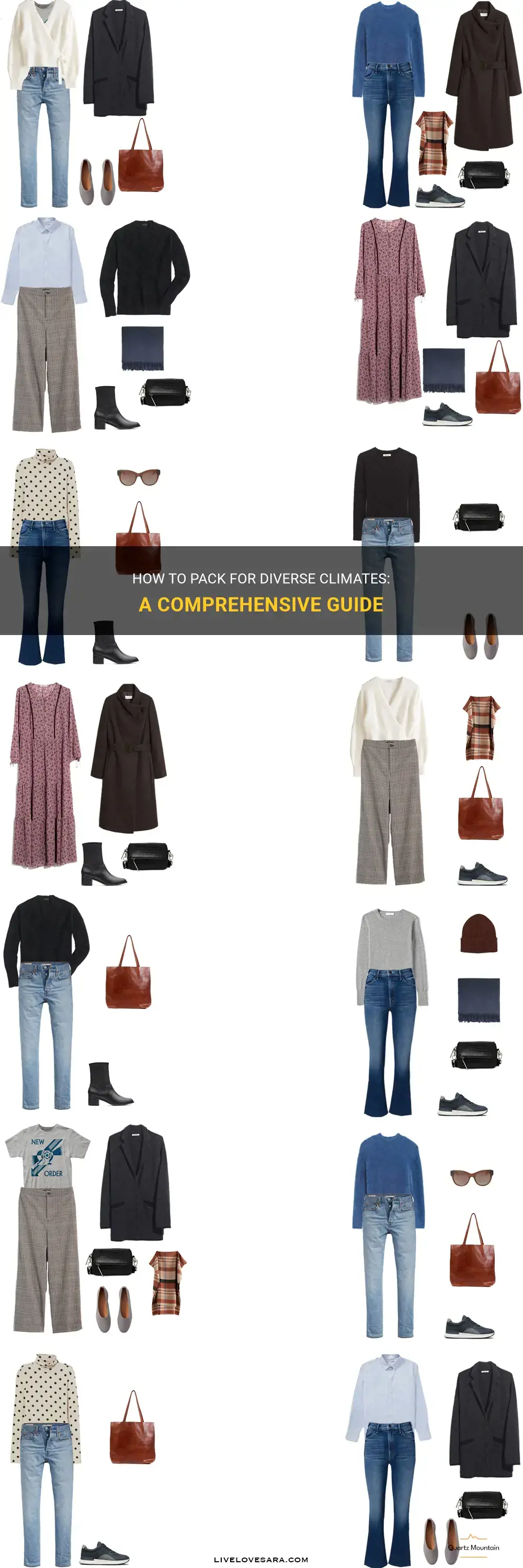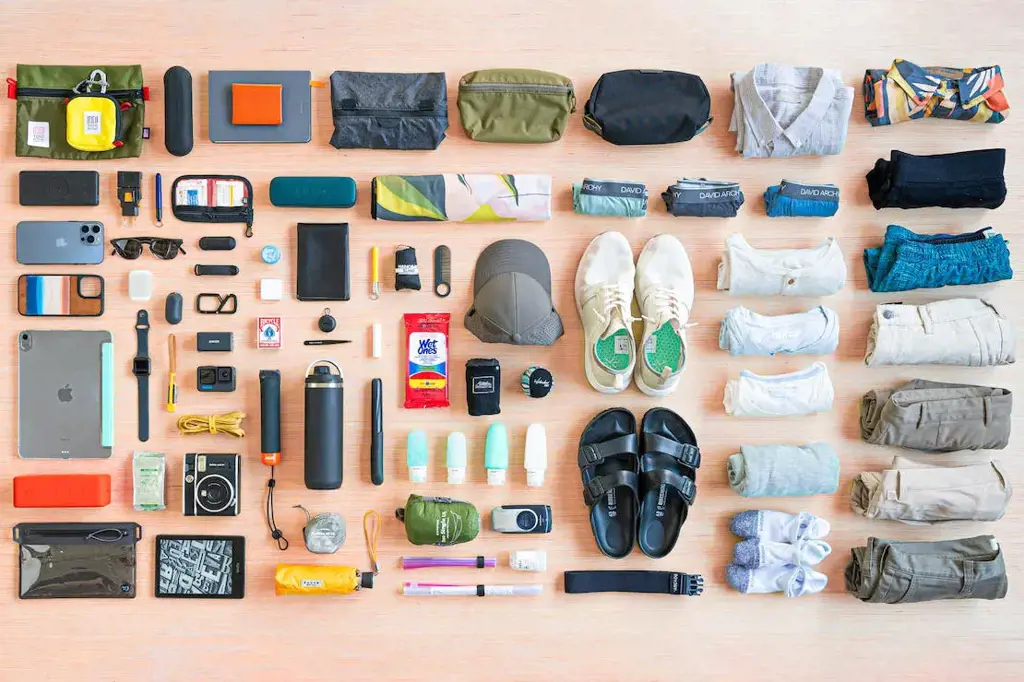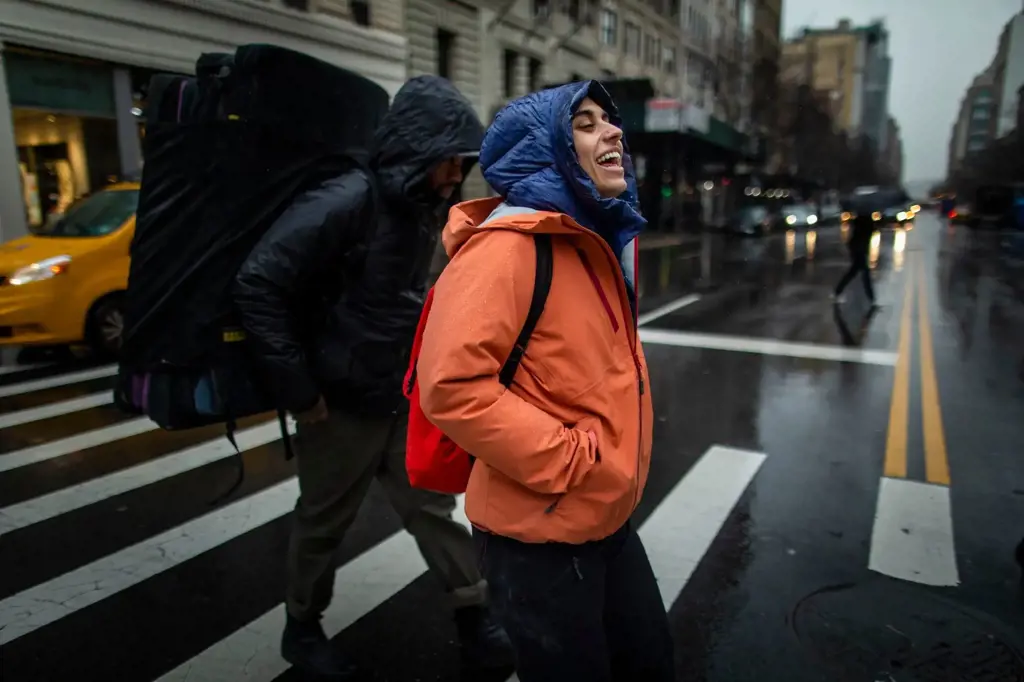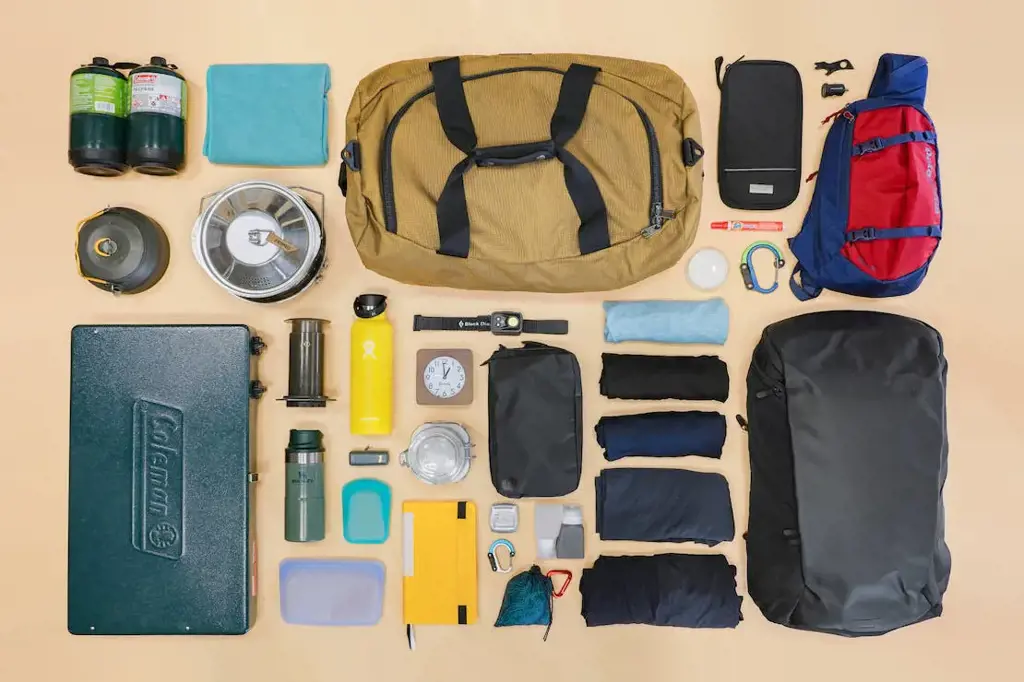
Packing for a vacation in diverse climates can be a daunting task. From sweltering heat to freezing cold, how do you ensure you have everything you need for every possible weather condition? Whether you're embarking on a multi-destination trip or simply want to be prepared for any unexpected weather changes, our comprehensive guide on how to pack for diverse climates will equip you with the knowledge and tips you need to pack smartly and efficiently. So sit back, relax, and let us take the stress out of packing for your next adventure!
| Characteristics | Values |
|---|---|
| Temperature | Hot, warm, cold |
| Humidity | High, moderate, low |
| Precipitation | Rainy, snowy, dry |
| Wind | Windy, calm |
| Clothing | Light, medium, heavy |
| Footwear | Sandals, sneakers, boots |
| Accessories | Hat, sunglasses, umbrella |
| Skincare | Sunscreen, moisturizer, lip balm |
| Outdoor Gear | Backpack, hiking boots, rain jacket |
| Season | Summer, spring, fall, winter |
What You'll Learn
- What are the essential items to pack for a tropical climate?
- What should I bring for a trip to a cold, snowy climate?
- Are there any specific items I should pack for a desert climate?
- What clothing should I bring for a trip to a rainy, temperate climate?
- Are there any universal items that are necessary for any climate?

What are the essential items to pack for a tropical climate?

When planning a trip to a tropical climate, it's essential to pack the right items to ensure your comfort and enjoyment. The warm weather and high humidity can make it challenging to stay cool and protect yourself from the elements. Here are some essential items to pack for a tropical climate:
- Lightweight and breathable clothing: Opt for loose-fitting, lightweight, and breathable clothing to help keep you cool. Choose fabrics such as cotton or linen that allow air to circulate and wick away moisture. Avoid dark colors as they absorb heat. Pack items like t-shirts, shorts, dresses, and skirts for a comfortable and casual look.
- Sun protection: The sun's rays can be intense in tropical regions, so it's imperative to pack sun protection items. Remember to bring sunscreen with a high SPF to protect your skin from harmful UV rays. Additionally, a wide-brimmed hat, sunglasses, and a lightweight, long-sleeved shirt can provide extra coverage and shield you from the sun's rays.
- Insect repellent: Tropical climates often come with a higher risk of mosquito-borne diseases such as dengue fever or malaria. To protect yourself from insect bites, pack an effective insect repellent containing DEET or picaridin. You may also consider bringing lightweight, long-sleeved clothing to cover your arms and legs during the evening when mosquitoes are most active.
- Comfortable footwear: Choose lightweight and comfortable footwear such as sandals or flip flops for casual outings and beach days. For activities like hiking or exploring rough terrain, consider packing a pair of sturdy and supportive shoes. Remember to break in new shoes before your trip to avoid discomfort and blisters.
- Water bottle: Staying hydrated is crucial in a tropical climate, where the heat can quickly lead to dehydration. Bring a reusable water bottle and fill it often to ensure you have access to clean, safe drinking water throughout your trip. Consider a bottle with insulation to keep your water cool in hot weather.
- Swimwear: Don't forget to pack swimwear, especially if you plan on spending time at the beach or staying at resorts with swimming pools. Choose comfortable and fast-drying options such as swim trunks, bikinis, or one-piece swimsuits.
- Lightweight rain gear: Tropical climates often experience sudden rain showers, so it's wise to pack a lightweight rain jacket or poncho. These can help keep you dry during unexpected downpours while allowing your skin to breathe in humid conditions.
- Medications and first aid kit: It's always a good idea to pack any necessary medications and a basic first aid kit when traveling. In tropical climates, you may encounter different health risks, such as traveler's diarrhea or skin irritations. Include items such as pain relievers, antihistamines, band-aids, and antiseptic wipes to address common ailments.
- Electronics protection: Humidity and sudden rain showers can pose a threat to your electronic devices. Consider packing a waterproof or water-resistant case or bag to protect items like your phone, camera, or tablet.
Remember to check the weather forecast for your destination before packing to get a better idea of what to expect. It's also a good idea to pack a combination of both lightweight and slightly warmer clothing as tropical climates can sometimes experience cooler evenings or air-conditioned indoor spaces. By packing the right items, you'll be well-prepared to enjoy your tropical getaway with comfort and peace of mind.
Essential Items to Pack for Your C-Section Recovery
You may want to see also

What should I bring for a trip to a cold, snowy climate?

When planning a trip to a cold, snowy climate, it is important to be prepared and pack the necessary items to ensure your comfort and safety. Whether you are heading to the mountains for a skiing trip or visiting a snowy destination for a winter vacation, here is a list of things you should bring with you.
- Warm clothing: Layering is key when it comes to staying warm in a cold climate. Start with a base layer made of thermal or moisture-wicking material, such as merino wool or synthetic fabrics. This will help regulate your body temperature and keep you dry. Next, add a mid-layer, such as a fleece or sweater, for extra insulation. Finally, top it off with a waterproof and windproof outer layer, such as a winter jacket or a parka, to protect yourself from the elements. Don't forget to bring thermal socks, gloves, and a hat to keep your extremities toasty.
- Footwear: When it comes to footwear, opt for insulated and waterproof boots with good traction. This will help keep your feet warm and dry, as well as prevent slipping on icy surfaces. Look for boots with a thick sole and a high ankle height for added support and protection.
- Accessories: In addition to warm clothing and footwear, there are a few accessories that can make a big difference in your comfort level. A good pair of sunglasses with UV protection is essential to protect your eyes from the glare of the sun on the snow. A neck gaiter or a scarf can help protect your face from the wind and cold. Hand warmers and toe warmers are also handy to have on hand for extra warmth.
- Moisturizers and lip balms: Cold and dry climates can be harsh on your skin. Be sure to pack moisturizers and lip balms to keep your skin hydrated and prevent chapped lips. Look for products that are specifically formulated for cold weather conditions, as they tend to be more effective in protecting and nourishing your skin.
- Medications and first aid kit: It is always a good idea to bring any necessary medications and a basic first aid kit with you. Cold climates can be challenging for some individuals, so it is important to be prepared for any possible health issues or injuries that may arise.
- Snow gear: If you are planning on participating in winter activities such as skiing, snowboarding, or snowshoeing, don't forget to pack the appropriate gear. This may include ski or snowboard equipment, helmets, goggles, and gloves specifically designed for these activities. It is also a good idea to bring a backpack to carry any necessary items while on the slopes.
- Emergency supplies: In cold, snowy environments, it is important to be prepared for unexpected emergencies. Pack a small survival kit with items such as a whistle, a flashlight, extra batteries, a pocket knife, and a small shovel. These items can come in handy if you find yourself in a challenging situation, such as getting stranded in a snowstorm.
Remember, it is better to over-prepare than to find yourself unprepared in a cold, snowy climate. By bringing the right clothing, footwear, accessories, and emergency supplies, you can ensure a safe and enjoyable trip to your snowy destination.
Essential Items to Pack for Backpacking Adventure in Central America
You may want to see also

Are there any specific items I should pack for a desert climate?

Are there any specific items you should pack for a desert climate? Absolutely! The desert can be an extreme environment with scorching heat, minimal shade, and limited sources of water. To ensure you have a comfortable and safe experience in the desert, it is important to pack the right essentials. Here are some specific items you should consider packing for a desert adventure:
Sun Protection:
The desert sun can be intense, so it is crucial to protect your skin and eyes from harmful UV rays. Carry a wide-brimmed hat or cap to shield your face and neck from direct sunlight. Don't forget to pack a pair of sunglasses with UV protection to keep your eyes safe.
Lightweight and Breathable Clothing:
Opt for loose-fitting, lightweight, and breathable clothing to help regulate your body temperature. Choose fabrics like cotton or linen that allow air circulation and absorb sweat, keeping you cool and comfortable. It is also advisable to wear long-sleeved shirts and long pants to protect your skin from the sun and potential hazards like thorny plants or insects.
Desert-Friendly Footwear:
Invest in a sturdy pair of hiking boots or closed-toe shoes with good ankle support. The desert terrain may be uneven and rocky, so it is essential to have proper footwear that can handle the conditions. Additionally, pack a pair of sandals or flip-flops to let your feet breathe during rest periods.
Water and Hydration:
Staying hydrated is crucial in the desert, where dehydration can occur rapidly. Carry a sufficient amount of water in a reusable water bottle or hydration pack. It is recommended to drink at least one liter of water per hour when active in the desert. You can also consider packing oral rehydration salts or electrolyte tablets to replenish lost minerals.
First Aid Kit:
Always have a well-stocked first aid kit on hand. Include essentials such as bandages, antiseptic ointment, tweezers, pain relievers, and any personal medications you may need. In the desert, minor cuts, scrapes, and blisters can become more severe if not properly treated.
Navigation Tools:
It is easy to get disoriented in the vast and featureless desert landscape. Carry a reliable map, compass, or a GPS device to help you navigate and stay on track. Additionally, familiarize yourself with the area and have a backup plan in case of unexpected circumstances.
Shelter and Sleeping Gear:
If you plan to spend the night in the desert, pack a lightweight and compact tent or a spacious tarp for shade. The desert temperature can drop significantly at night, so bring a warm sleeping bag, a sleeping pad for comfort, and a lightweight camping stove for cooking meals.
Insect Repellent and Sunscreen:
Protect yourself from annoying insects and potential insect-borne diseases by applying insect repellent. Look for a product with DEET or picaridin, which are effective against a wide range of insects. Additionally, use a broad-spectrum sunscreen with at least SPF 30 or higher to shield your skin from harmful sunburns.
Emergency Supplies:
It is always wise to be prepared for unforeseen circumstances. Pack an emergency whistle, fire starter kit, flashlight or headlamp with extra batteries, a multi-tool, and a compact emergency blanket. These items can be life-saving in case of emergencies or if you get stranded in the desert.
Remember, the desert environment can be challenging, but with the right preparation and essential items, you can have a safe and enjoyable experience. Prioritize your safety and comfort by packing the necessary gear and being knowledgeable about the potential risks and hazards of the desert climate.
Essential Items for Your Bucket List Family Adventure: What to Pack
You may want to see also

What clothing should I bring for a trip to a rainy, temperate climate?

When packing for a trip to a rainy, temperate climate, it is important to bring clothing that will keep you dry, warm, and comfortable. The following guide will help you choose the right clothing for your trip.
Waterproof Outerwear:
One of the most essential items to pack for a rainy climate is a waterproof or water-resistant jacket. Look for jackets made from materials such as Gore-Tex or nylon with a waterproof coating, as they will provide the best protection against rain. Make sure the jacket is also breathable to prevent you from getting too hot and sweaty.
Layering:
In a temperate climate, temperatures can vary throughout the day, so it is important to layer your clothing. Start with a moisture-wicking base layer made of materials like merino wool or synthetic fabrics. This will help keep you dry by wicking away sweat from your body. Add a mid-layer, such as a fleece or lightweight down jacket, for insulation. Finally, top it off with a waterproof outer layer for protection against rain and wind.
Waterproof Pants:
In addition to a waterproof jacket, it is also wise to pack a pair of waterproof pants. Look for pants that are made from the same waterproof materials as your jacket. These pants will keep your legs dry and protect against wet vegetation and puddles.
Headwear and Accessories:
Don't forget to protect your head and extremities from the rain. Pack a waterproof hat or a hat with a wide brim to keep rain off your face. Consider bringing a lightweight, waterproof beanie for extra warmth. Gloves or mittens can also be useful, especially if the temperatures drop. Lastly, bring a pair of waterproof shoes or boots to keep your feet dry.
Quick-dry Clothing:
When traveling in a rainy climate, it is likely that your clothes will get wet. To prevent discomfort, pack clothing made from quick-drying materials, such as synthetic blends or merino wool. This will allow your clothes to dry faster, ensuring you stay comfortable throughout your trip.
Extras:
Consider packing a travel-size umbrella for added protection during short rain showers. Additionally, bring a lightweight, packable rain poncho that can easily fit in your daypack. These extras will provide additional protection if you find yourself caught in unexpected downpours.
In summary, when packing for a trip to a rainy, temperate climate, it is important to bring waterproof outerwear, layer your clothing, include waterproof pants, protect your head and extremities with appropriate accessories, choose quick-dry clothing, and consider bringing extras like an umbrella or rain poncho. By being prepared and packing the right clothing, you can enjoy your trip to a rainy destination without worrying about staying dry and comfortable.
Essential Items to Pack for the Weather in Malaysia
You may want to see also

Are there any universal items that are necessary for any climate?

When traveling to different climates, it can be challenging to pack the right items. Different weather conditions require different clothing and accessories to stay comfortable. However, there are a few universal items that are necessary for any climate. These items are essential for protecting yourself from the elements and ensuring a comfortable journey.
One such item is a good quality sunscreen. Sunscreen is necessary no matter where you are going. Even in colder climates, the sun's rays can be harmful to your skin. It is crucial to protect yourself from UV radiation to prevent sunburn and reduce the risk of skin cancer. Choose a broad-spectrum sunscreen with a high SPF and apply it daily, regardless of the weather.
Another universal item is a versatile and lightweight jacket or sweater. Regardless of the climate, temperatures can drop unexpectedly, especially during the evening or in higher altitudes. Having a layering piece that can easily be added or removed is essential for staying comfortable. Opt for a jacket or sweater made from breathable materials that can provide warmth without causing overheating.
Comfortable and durable shoes are also a must for any climate. Whether you are walking on sandy beaches, rugged mountains, or city streets, having supportive footwear is essential. Look for shoes that are suitable for the activities you will be engaging in and provide adequate support for your feet. Remember to break them in before your trip to avoid blisters and discomfort.
A versatile and moisture-wicking clothing material is another universal item to consider. Fabrics like merino wool or technical synthetics are excellent choices as they can regulate body temperature and wick away sweat. These materials are suitable for a wide range of climates and activities, keeping you cool in hot weather and warm in colder conditions.
Additionally, a reliable water bottle is crucial for staying hydrated in any climate. Dehydration can occur even in colder climates, so it is essential to have easy access to water at all times. Opt for a reusable water bottle that can withstand different temperatures and is easy to carry with you.
Lastly, don't forget to pack a good quality insect repellent. Insects can be a nuisance no matter where you are, and some areas might be prone to mosquitoes or other biting insects. Protect yourself from itchy bites and potential disease transmission by applying an effective insect repellent.
In conclusion, while different climates require different items, there are a few universal essentials that are necessary for any trip. These include sunscreen, a versatile jacket or sweater, comfortable shoes, moisture-wicking clothing, a reusable water bottle, and insect repellent. By packing these items, you can ensure that you are prepared for a wide range of weather conditions and enjoy your journey comfortably and safely.
Essential Items for Your Trip to India: What to Pack
You may want to see also
Frequently asked questions
When packing for a tropical climate, it's important to prioritize lightweight and breathable clothing. Opt for clothing made of natural fibers like cotton or linen, as they will help keep you cool and comfortable in the heat. Don't forget items like swimsuits, flip-flops, and sunscreen to enjoy the beach. Pack a hat to protect yourself from the sun, and remember to bring bug spray to ward off mosquitoes.
When packing for a cold climate, layering is key. Pack plenty of warm and insulating clothing, such as sweaters, thermal underwear, and thick socks. A waterproof and insulated jacket is essential to protect you from the elements. Don't forget hats, scarves, and gloves to keep your extremities warm. It's also a good idea to bring sturdy boots with good traction to navigate icy or snowy terrain.
When preparing for a rainy climate, it's important to pack items that will keep you dry. Opt for a waterproof jacket or raincoat, as well as waterproof footwear like rain boots. Pack an umbrella or a compact rain poncho for added protection. It's also a good idea to bring quick-drying clothing to ensure that you stay comfortable in wet conditions. Consider packing a waterproof bag to protect your belongings from getting wet.
When packing for a desert climate, it's crucial to prioritize sun protection. Bring lightweight and loose-fitting clothing that will help keep you cool while also protecting you from the harsh sun. Don't forget to pack a wide-brimmed hat, sunglasses, and sunscreen. It's also essential to stay hydrated, so bring a reusable water bottle and consider packing electrolyte packets to replenish any lost minerals.
When packing for a temperate climate, it's important to prepare for a wide range of temperatures. Pack a variety of clothing options that can be easily layered, such as t-shirts, lightweight sweaters, and a medium-weight jacket. Bring comfortable walking shoes or sneakers for exploring. You may also want to bring an umbrella or a light rain jacket in case of unexpected showers.







